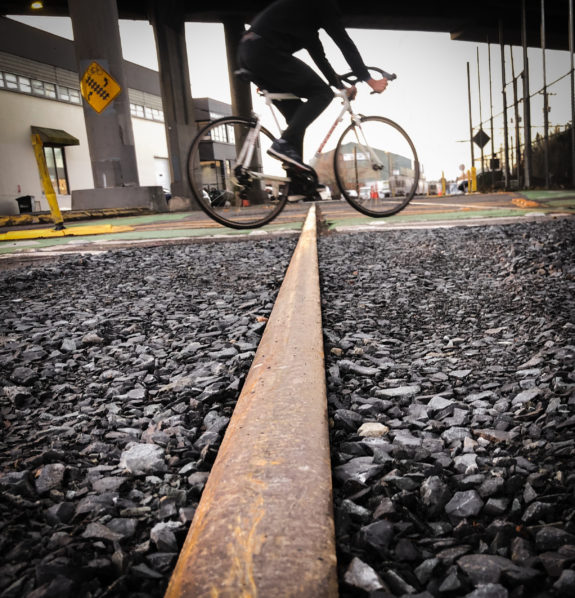Seattle reaches agreement with railroad to pave over dangerous tracks under the Ballard Bridge

In a surprise development in the long, injurious and frustrating history of the Ballard Missing Link of the Burke-Gilman Trail, Councilmember Dan Strauss announced Tuesday an agreement with the Ballard Terminal Railroad Company that should set the city up to pave over the rarely used tracks near and under the Ballard Bridge.
This is a coming together moment," said Strauss during Tuesday's City Council meeting (starts around the 1:37 mark in this video). Parties that typically disagree, we have found agreement here." Because the city owns the land under the tracks and leases it to the railroad, a city ordinance is required in order to approve the transfer from the Ballard Terminal Railroad to another entity called the Meeker Southern Railroad, which the Ballard Terminal Railroad Company owns. The Council agreed unanimously to put the ordinance on an accelerated path in order to get it approved in time for crews to pour the asphalt before the end of the year. A final vote is scheduled for October 24.
A group of people who were injured while biking in this area sued the city and Ballard Terminal Railroad in 2022, and their settlement agreement led the city to make a confusing series of changes in early 2023 and commit to building a more complete rail crossing by the end of the year. Another group of injured people have since filed claims. This is part of the urgency in passing this ordinance. Though the city's initial plan for a second phase of changes would have kept the rails in place, paving over the rails (and the recently-dug gravel pits) is a much better solution if that is an option.
The full text of the ordinance is not yet posted on the Council's calendar, but Strauss said it would authorize the SDOT Director to approve the transfer of the railway franchise from the Ballard Terminal Railroad Company to the Meeker Southern Railroad." He did not specify the begin and end points of the section to be abandoned or why transferring the railway franchise to a subsidiary is necessary.
Cascade Bicycle Club celebrated the news and urged the Council to approve the ordinance. Cascade supports paving over the hazardous and dis-used railroad tracks that have caused countless crashes and injuries over the past two decades," said Cascade Bicycle Club Executive Director Lee Lambert. This would be a step forward in making this short section of the Missing Link safer. We'd like to thank SDOT andthe Ballard Terminal Railroadfor reaching an agreement to completely cover the railroad tracks to ensure people can safely bicycle through that area of Ballard. However, this project is just the first step in closing theMissing Link." Cascade said they would continue advocating for building the designed trail plan along Shilshole Ave.
Paving over the tracks is the most obvious solution to fixing the notoriously dangerous area near and under the Ballard Bridge, where people biking must cross the poorly-maintained rails. The uneven gaps between the pavement and rails and the awkward shallow angle that they cross the roadway has caused countless people to crash, sometimes resulting in very serious injuries. However, Federal regulations protecting railroads make it essentially impossible for the city to condemn the railway so long as an operator continued to apply for a lease and maintain even minimal use. So even though the Ballard Terminal Railroad barely ever runs trains on the tracks, they remain active and protected by Federal railroad laws. Ballard Terminal Railroad would need to voluntarily abandon their railroad lease in order for the city to pave over the tracks, and that seems to be what they are doing through this legislation.
Both the city's fully-designed Shilshole alignment for the trail as well as the Leary/Market concept that Councilmember Strauss recently proposed would travel along NW 45th Street under the Ballard Bridge and would need to cross the tracks somewhere around there. So paving over this section of track should not necessarily commit the city to either option, though this is a detail trail advocates will need to watch closely.
Though both sides seem to be in agreement about this ordinance, assuming it really does lead to paving over at least some of the rails, there is still essentially zero trust between trail advocates and the industrial business leaders who have been fighting the trail. Anyone who has been engaged with this frustrating fight will be asking, What's the catch?" Hopefully there isn't one, but I doubt any trail supporter is going to just take the railroad's word on that. Trail appellants including the Ballard Terminal Railroad burned through all of their trustworthiness many years ago.
All the studies of Missing Link options throughout the years have precluded a railbed option similar to most of the rest of the Burke-Gilman Trail because this section of tracks was still legally considered in use. This is why every design option has been limited by its track-crossing options and why the design runs alongside the tracks. In many cases, parking, loading dock easements, and even two-way general purpose travel has had to be limited because the rarely-used tracks needed to remain open. Abandoning tracks could also have interesting implications for the sections in Frelard and near Fred Meyer. Tracks occupy a lot of land there, especially the double-tracked section near Fred Meyer. This section of tracks has been inaccessible ever since Seattle Public Utilities started work on NW 45th Street. If nothing else, maybe this could lead to an improved trail design near 6th Ave NW, where the trail curves sharply to cross the tracks. But also, this would be a lot of newly-accessible public land with a lot of possibilities for the neighborhood.